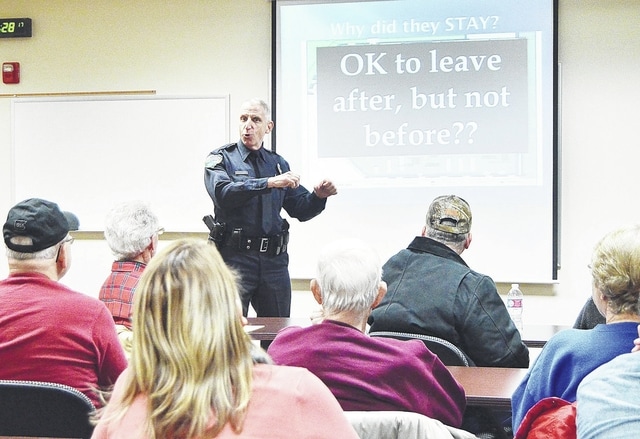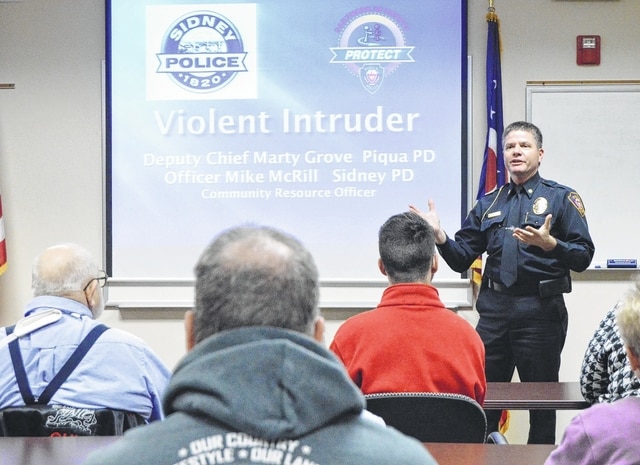

SIDNEY – Realistic discussion of a disturbing act of violence is being brought to the citizenry of Shelby and Miami Counties. Local officers are heading up efforts to “change the mindset” of how to react when an active shooter intrudes a public place.
“We don’t want to scare you, just to prepare you,” was the message throughout a 90-minute public presentation at the Sidney Police Department Tuesday night.
On Tuesday, Community Resource Officer Mike McRill joined with Deputy Chief Marty Grove of the Piqua Police Department in continuing an ongoing awareness program in case a shooter enters a local business, school, church and any building with mass murder in mind.
A crowd of 38 gathered Tuesday and are now part of more than 2,000 people receiving the information throughout both counties. Presentations to industries, small businesses, school personnel and others are allowing a plan to be developed for that particular entity, according to the officers.
“We live in an authority-driven society. Basically we do what we’re told. That’s why schools have fire drills and there are rules in our workplaces,” said McRill. “We have to change the mindset in order to survive.”
Grove said, “There are no rules in this fight. Do not think this is a fair fight. Know that person is trying to kill you and do whatever you have to do to stop him.”
Both officers informed the group that protecting the public is their job. They apologized in advance for speaking with an open, frank tone.
McRill stated, “If you think the police are going to save you when it begins (a shooter opening fire nearby), it’s not going to happen. It usually takes five to six minutes for police to respond to such a call and enter a building. How many of you (pointing at half the crowd with his hand forming a gun shape) could I shoot in five or six minutes? I would say most of you and I may not even have to reload. You just cannot wait on us in order to survive.”
Grove said he and McRill are members of the local SWAT team. Realistically, it could take up to 45 minutes to assemble the team, gear up and arrive at the scene before confronting a shooter.
“That’s what happened at Columbine (April 20, 1999). Police surrounded the school and waited for SWAT. They did what they were supposed to do. That’s the way they were trained on how to handle that. The students were trained to hide under their desks instead of trying to get away. At Columbine, the shooters were in the library seven and a half minutes killing 10 people before they moved on,” said Grove.
“Our job here is to reduce the body counts in such a situation. When Columbine happened, it all changed. We began looking at better ways to handle these situations,” he added.
The officers said people need to “have permission” to do whatever is necessary to survive. While the comment seemed logical, they explained that such life and death situations cause people to react in a myriad of ways. Whether they are calm or panicked, many times people will not break company rules during such a crisis.
“It’s against the rules to jump off a loading dock at a company, and people won’t do it, even if it means saving their life. They won’t take a computer and throw it through a window to allow them to escape because it’s destroying company property. Remember, this person has made a decision to kill you, and you have to do what you can to stop him,” said McRill.
They spoke of the Run-Hide-Fight way of thinking, if someone is caught in a shooting scenario. The first idea is to run away from the shooter. Grove said typically the shooters are looking for “high body counts” and the victim choice is random usually the ones nearest the door.
In most cases, shooters know they have a short time (usually 8 minutes) before they encounter law enforcement. Many do not want that showdown and have already decided to take their own lives.
“These people are chicken. They don’t want to face what they know is coming, so they end it themselves,” Grove said.
McRill said to leave belongings behind, help others escape and prevent people from entering the building. He said if individuals or groups are frozen by fear and unable to move, there is no choice but to continue your escape on your own. He spoke of exiting through windows noting that a second story jump may cause a bodily injury, but it’s less harmful than a gunshot.
If unable to getaway, McRill said to hide. Not only to be concealed but also try for something a bullet may not penetrate. They told of building barricades in front of doors, tying door knobs and overhead door hinges to prevent opening, overturn filing cabinets, blocking pathways with microwave ovens.
“Do anything you have to do to slow the intruder from entering the workplace. If they’re working on the door, they’re not pulling the trigger. That is what we want, no one getting shot,” McRill said.
Using a slide presentation, McRill demonstrated he could literally use trash to slow down entry. He wound a trash bag into a plastic rope and an empty plastic water bottle to wedge into a door hinge to prevent it from opening. He showed that placing a microwave oven and coffee stand nearer a door to the kitchen, they could be easily moved to block the door from opening.
The same kitchen was used to segue into the final option of fighting back.
McRill said once barricaded in the kitchen and the killer was trying to break in, what options does someone have? The slide showed all the cabinet doors and drawers being opened displaying dishware, knives and cleaning chemicals.
“Remember, this person is trying to kill you. If they are that close throw things, scream, stab them with scissors or a pencil or pen (targeting the face), and try to break their hand with anything you can find if they reach through an opening. Always act with physical aggression in this situation,” McRill said.
Grove said if confronted, a crowd could rush the shooter. He said people would most likely be shot and even killed, but buying time to escape and minimize the number of bullets fired is most important.
The men offered advice for those with Concealed Carry Weapons permits and are armed.
“Remember that we (police officers) are not going to know you. We are going to be looking for someone with a gun. If you are the one we see, we will do what we need to eliminate the threat,” McRill said.
He added, once officers enter the area, permit holders should lay their gun down and keep their hands visible. They will be handcuffed and taken into custody. McRill said not to resist as the situation will be fully determined in short order.
The pair is continuing to meet with businesses, schools, government office employees and other organizations to provide an educational plan for such an ordeal.
McRill said, “The mental decision is the toughest. The plan to hope, pray and beg him not to shoot, is just not the best way to handle this.”



